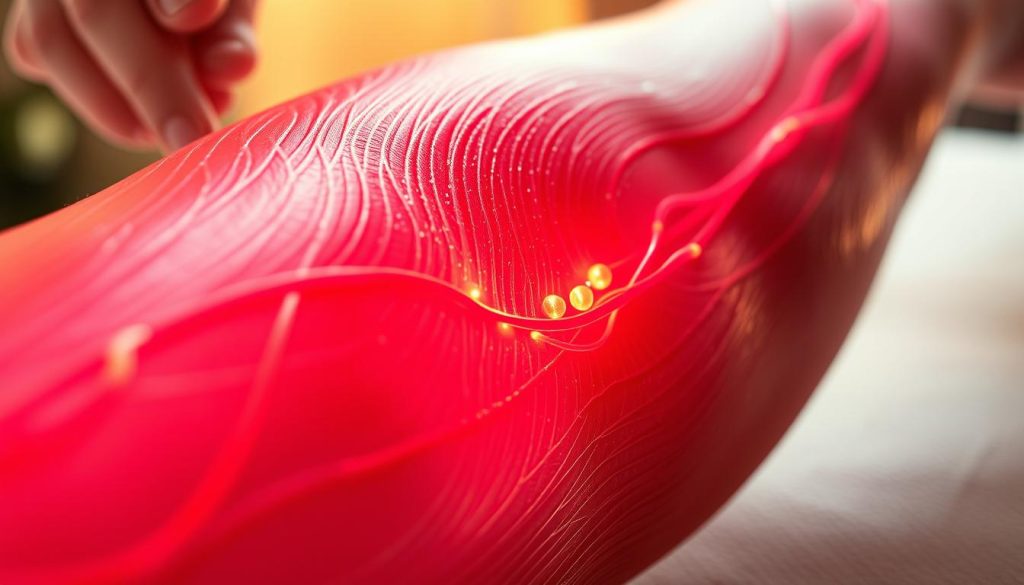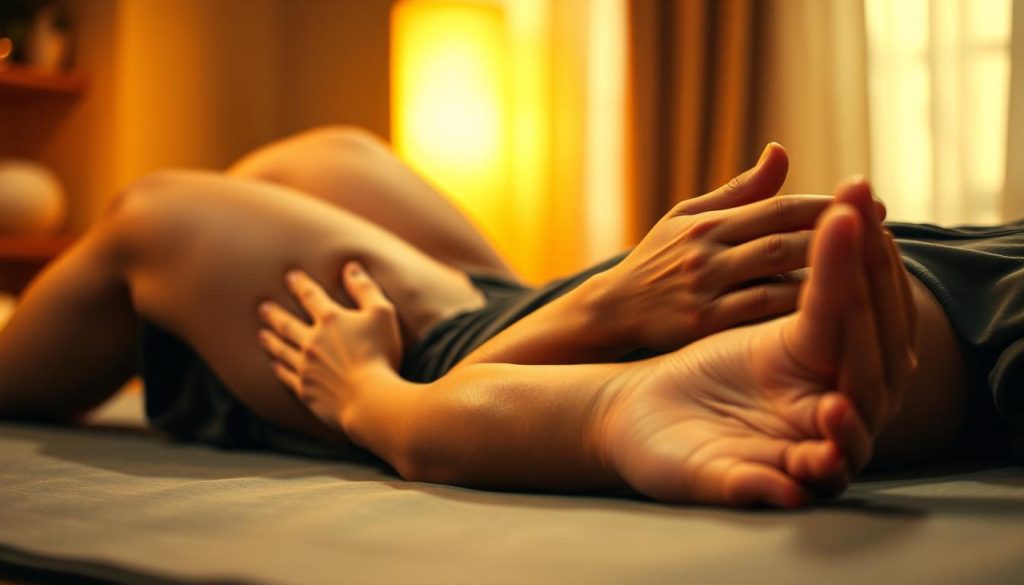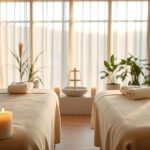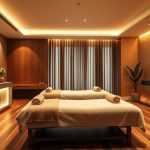Ever wonder why your muscles feel like concrete after a tough session? That deep ache isn’t just punishment—it’s your body asking for help. While you’ve been icing and resting, there’s a secret weapon you’re probably overlooking.
What if one simple addition to your routine could slash that pain and boost your performance? Research shows that massage can reduce muscle soreness by approximately and significantly decrease swelling. This isn’t just about feeling good—it’s about working smarter.
Forget thinking of rubdowns as luxury spa treats. Serious athletes use this therapy to accelerate repair and enhance growth. Whether you’re dealing with stiffness or seeking better flexibility, the right technique makes all the difference. Specific massages target tension and improve, turning your recovery from a chore into a advantage.
Ready to transform how you bounce back? Let’s explore how incorporating this practice revolutionizes your results.
Key Takeaways
- Massage can reduce post-exercise muscle soreness by about 30%.
- It helps decrease swelling and inflammation after workouts.
- Proper techniques improve blood flow and ease stiffness.
- Different massage types target specific recovery needs.
- Adding massage to your routine supports muscle growth.
- It enhances flexibility and reduces overall tension.
- Better recovery leads to improved athletic performance.
Why Your Sore Muscles Are Begging for a Massage
Ever feel like your body is staging a protest after pushing it too hard? That deep ache isn’t just random drama—it’s a biological SOS. Understanding what’s happening beneath the surface explains why targeted massage therapy isn’t optional; it’s essential.
The Science Behind DOMS (Delayed Onset Muscle Soreness)
DOMS typically hits 24-48 hours after exercise. It’s your body’s response to unfamiliar or intense activity. Microscopic tears form in muscle fibers during strength training. This damage triggers inflammation and metabolic waste accumulation.
Think of these micro-tears as necessary construction for muscle growth. They signal your body to rebuild stronger. But without proper recovery, this process becomes counterproductive. The resulting muscle stiffness limits your range motion and performance.
How Inflammation Slows Down Your Progress
Inflammation acts like an overzealous security guard after workouts. It means well but often overstays its welcome. This biological response traps fluid and metabolic byproducts in tissues. The resulting pressure on nerves creates that familiar pain and tightness.
This inflammatory environment hinders nutrient delivery to damaged areas. It delays repair and compromises future workout quality. Essentially, inflammation transforms your muscles from construction zones into traffic jams.
| Recovery Factor | Without Massage | With Massage |
|---|---|---|
| Inflammation Duration | 48-72 hours | 24-48 hours |
| Muscle Stiffness | Significant | Minimal |
| Next Workout Performance | Compromised | Enhanced |
| Range of Motion | Limited | Improved |
Persistent inflammation creates a cycle of soreness and reduced performance. It’s why skipping post-workout recovery strategies is like building on shaky foundations. Your body needs help moving from repair mode to growth mode.
This is where massage enters as your biological bouncer. It helps evict inflammatory compounds and metabolic waste. The improved blood flow brings fresh nutrients to damaged tissues. This accelerates the natural recovery process your muscles desperately need.
How Massage Therapy Supercharges Your Recovery
Think of your muscles after a tough session as a construction site that needs cleanup. The real magic happens when you bring in the professional cleanup crew. This is where targeted bodywork becomes your secret weapon for bouncing back faster.

Boosting Blood Flow to Flush Out Toxins
Your circulatory system becomes a superhighway during massage. The kneading and pressure create a pumping action that pushes fresh, oxygen-rich blood into tired tissues.
This increased circulation acts like a biological detox. It washes away metabolic waste and inflammation-causing compounds. Your muscles get the nutrients they need while saying goodbye to the garbage.
The result? Less pain and faster repair. You’re essentially giving your body an internal shower that cleans out all the workout gunk.
Reducing Muscle Stiffness and Improving Flexibility
Stiff muscles are like rusty hinges—they need oiling to move smoothly. Massage works as that lubricant, breaking up tension and adhesions.
The techniques gently persuade tight fibers to relax and lengthen. This restoration of natural muscle length means better range motion and less stiffness.
You’ll notice you can move more freely without that “tin man” feeling. Improved flexibility means better performance in your next session and fewer awkward stair descents.
This approach turns recovery from a waiting game into an active process. Your body gets the help it needs to rebuild stronger than before.
Your Post-Workout Massage Menu: Techniques to Know
Think of your recovery options like a well-stocked toolbox. Each technique serves a unique purpose in your muscle repair journey. Knowing which tool to use when separates average results from exceptional ones.
Not all rubdowns are created equal. Some soothe while others solve specific problems. Your post-workout needs demand a strategic approach.
The Soothing Power of Swedish Massage
Swedish massage acts like a gentle friend for your tired body. It uses long, flowing strokes to improve circulation. This technique promotes relaxation without intense pressure.
Your muscles receive fresh oxygen-rich blood during this process. It helps flush out metabolic waste from your recent exercise. The gentle approach reduces soreness while maintaining comfort.
This type of massage therapy works wonders immediately after workouts. It prepares your body for the recovery process without adding stress.
When to Consider Deep Tissue (Hint: Not Right After the Gym)
Deep tissue massage focuses on deeper muscle layers. It works out chronic tension and stubborn knots. But timing matters tremendously with this approach.
Avoid this technique right after intense exercise. The pressure could increase inflammation in already stressed tissues. Your body needs gentle care immediately following workouts.
Consider deep tissue work on rest days instead. It addresses long-standing issues without interfering with acute recovery. This strategic timing maximizes benefits while minimizing risks.
The Targeted Approach of Trigger Point Therapy
Trigger point therapy hunts down specific muscle knots. These sensitive spots can refer pain to other areas. Targeted pressure releases these troublesome zones.
This method feels like sending a rescue team to problem areas. It addresses localized tension that affects overall muscle function. The relief often feels immediate and significant.
Trigger point work complements other massage styles beautifully. It solves specific problems that general techniques might miss.
| Massage Type | Best Timing | Primary Benefit | Pressure Level |
|---|---|---|---|
| Swedish | Immediately post-workout | Improves circulation and relaxation | Light to medium |
| Deep Tissue | 24-48 hours after exercise | Addresses chronic tension patterns | Firm to deep |
| Trigger Point | When specific knots appear | Releases localized muscle tension | Targeted pressure |
| Sports Massage | Pre or post workout | Enhances athletic performance | Variable based on need |
Sports massage deserves special mention for active individuals. It combines various techniques to address athletic needs specifically. A skilled massage therapist tailors this approach to your fitness goals.
Myofascial release offers another valuable option. It applies sustained pressure to connective tissue. This technique improves flexibility and reduces overall tightness.
“The right massage at the wrong time is the wrong massage. Timing and technique selection determine your recovery success.”
Your post-workout routine benefits from this knowledge. Matching the massage type to your specific needs optimizes results. This strategic approach turns recovery into an active advantage.
Timing Is Everything: When to Get Your Massage
Getting your massage timing wrong is like putting sunscreen on after the sunburn. The magic happens when you catch that sweet spot between workout and recovery. Your body has different needs at different times, and understanding this rhythm transforms your results.
The Immediate Post-Workout Window
Right after your exercise, your muscles are like overexcited party guests. They need gentle guidance, not intense interrogation. This is prime time for light, circulation-focused work.
Think of immediate massage post-workout as first aid for your tissues. It boosts blood flow when your body needs it most. The gentle pressure helps flush metabolic waste before it settles in.
This approach reduces initial soreness and prepares your system for repair. It’s like cleaning the kitchen while you cook instead of facing a disaster later.
Why the Next Day Might Be Even Better
Sometimes waiting 24 hours lets your muscles say, “Okay, now I’m ready for help.” The initial inflammation calms down, making deeper work more effective.
Day-after massage therapy addresses the full bloom of DOMS. Your therapist can target specific tension points that have declared themselves. This timing often provides more significant relief from stiffness.
The next day approach works particularly well for intense strength sessions. It gives your body time to complete its initial repair processes before receiving additional help.
| Timing Approach | Best For | Pressure Level | Primary Benefit |
|---|---|---|---|
| Immediately After | Cardio & Light workouts | Gentle to Medium | Reduces initial soreness |
| 24 Hours Later | Strength training | Medium to Firm | Addresses developed tension |
| 48 Hours Later | Extreme DOMS | Firm (if tolerated) | Breaks persistent tightness |
“The perfect massage timing isn’t about watching the clock—it’s about listening to what your body is telling you it needs right now.”
Your ideal post-workout routine might mix both approaches. Light massages immediately after exercise prevent severe soreness. Follow-up sessions a day later tackle any remaining issues.
This strategic approach to incorporating massage creates a recovery cascade. Each session builds on the previous one’s benefits. The result is faster return to peak performance.
Remember that your fitness level and workout intensity affect ideal timing. Higher intensity often benefits from delayed deeper work. Listen to your body’s signals rather than sticking rigidly to schedules.
The right time maximizes every minute of your recovery process. It turns massage from a luxury into a precision tool for athletic excellence.
Practical Ways to Speed Up Post-Workout Muscle Recovery with Massage
What if you could give yourself professional-level relief without booking an appointment? Self-care techniques put recovery power directly in your hands—literally. You don’t need expensive equipment or advanced training to make a real difference.
Smart self-massage bridges the gap between professional sessions. It keeps your progress moving forward on rest days. Even brief attention to tired areas yields noticeable benefits.

Step-by-Step Guide to Self-Massage
Start with clean hands and comfortable positioning. Identify areas feeling particularly tight or sore from your recent activity. Apply gentle pressure initially before deepening your work.
Use your palms for broad compression techniques. Squeeze muscle groups gently to encourage circulation. Follow with light stretching holds to enhance flexibility.
Focus on upward motions toward your heart. This direction supports your natural blood flow patterns. It helps move metabolic waste toward elimination pathways.
Remember that discomfort shouldn’t cross into sharp pain. Your body responds better to persistent gentle pressure than aggressive digging. Self-massage techniques work best when they feel challenging but manageable.
Using Foam Rollers and Massage Guns Effectively (and Safely!)
Foam rollers offer excellent tension release for large muscle groups. Roll slowly across tight areas rather than rushing through motions. Pause on particularly sensitive spots for 20-30 seconds.
Vibrating rollers add therapeutic benefits to traditional rolling. The oscillations help calm nervous system responses to muscle tightness. They provide deeper release without excessive pressure.
Massage guns require careful technique for best results. Always start with the largest attachment head on the lowest setting. Move the device slowly upward along muscle fibers post-workout.
Avoid bony areas and joints with percussion devices. Keep sessions brief—5-10 minutes per muscle group usually suffices. Proper tool usage enhances recovery without risking tissue damage.
Even short DIY sessions support your body’s repair processes. Consistency matters more than marathon sessions when incorporating massage into your schedule.
Finding the Right Pro: Tips for Choosing a Massage Therapist
Ever hired someone who showed up with a wrench when you needed a scalpel? That’s the difference between a general relaxation massage and targeted sports therapy. Your recovery deserves precision tools, not just pleasant vibes.
Selecting the right massage therapist isn’t about finding someone with strong hands. It’s about finding someone who speaks the language of fitness. They should understand DOMS better than they understand spa music.
What to Look for in a Sports Massage Background
Credentials matter more than candle scents. Look beyond the basic license. Seek therapists with sports massage or medical massage therapy certifications.
Experience with athletes tells you they understand workout demands. They know how muscles react to different exercise types. This knowledge transforms their approach from generic to targeted.
Ask about their clientele. Do they work with runners, weightlifters, or weekend warriors? Their answer reveals their comfort with post-workout issues. You want someone who sees your body as an athletic instrument, not a relaxation project.
Check their continuing education. The best therapists constantly update their techniques. They incorporate new research about inflammation and recovery science.
How to Communicate Your Workout Goals Clearly
Your initial conversation sets the tone for everything. Describe your training schedule like you’re briefing a teammate. Mention your sport, frequency, and recent intensity changes.
Point out problem areas with specific details. Instead of “my shoulder hurts,” try “lateral deltoid pain during overhead presses.” This precision helps your therapist target the right tissues.
Discuss your goals beyond soreness relief. Do you want improved flexibility for deeper squats? Better performance in your next game? These details shape your massage post-workout strategy.
Give feedback during the session. A simple “lighter pressure there” or “that spot needs more attention” improves results. Good therapists welcome this dialogue—it makes them better at their job.
“The right therapist doesn’t just rub muscles—they read them like maps and navigate your recovery journey.”
Building this partnership takes time but pays dividends. Your massage therapist becomes part of your fitness team. They help you maintain peak condition through strategic body work.
Remember that incorporating massage into your routine requires the right professional partner. Sports massage services in Istanbul have grown significantly, reflecting athletes’ recognition of its value. Choose someone who makes your recovery their mission, not just their job.
Weaving Massage into Your Overall Fitness Routine
What if your calendar could predict your next PR? Strategic scheduling turns recovery from an afterthought into your competitive edge. Your body doesn’t know days of the week—it knows stress and repair cycles.
Smart athletes treat their massage schedule like military operations. They coordinate sessions around training intensity rather than convenience. This precision approach maximizes every minute of recovery.
Scheduling Massages Around Your Training Cycles
Your workout plan already follows periodization principles. Your massage therapy should mirror this intelligent structure. Different training phases demand different recovery strategies.
During heavy strength cycles, schedule deeper sessions 24-48 hours after workouts. This timing addresses developed tension without interfering with acute inflammation. The improved blood flow accelerates repair during growth phases.
Deload weeks become prime time for comprehensive massage work. Your body welcomes deeper attention when training intensity decreases. These sessions address lingering issues that intense exercise might mask.
Pre-competition massages focus on relaxation and flexibility. Light techniques reduce pre-event pain and anxiety. This approach primes your system for peak performance without draining energy.
| Training Phase | Massage Focus | Optimal Timing | Primary Benefits |
|---|---|---|---|
| Strength Building | Deep tissue & targeted work | 24-48 hours post-workout | Reduces muscle soreness, enhances growth |
| Deload Week | Comprehensive full-body | Mid-week recovery days | Addresses imbalances, improves flexibility |
| Peak Performance | Light circulation focus | 2-3 days before event | Reduces tension, maintains range motion |
| Active Recovery | Gentle maintenance | Same day as light exercise | Promotes blood flow, prevents stiffness |
Making Recovery as Important as the Workout Itself
Your muscles grow during rest, not during workouts. This biological truth makes recovery non-negotiable for serious athletes. Incorporating massage transforms passive waiting into active repair.
Block massage time like you schedule training sessions. Treat these appointments with equal importance to your gym time. This mindset shift acknowledges that recovery drives progress as much as effort.
Budget for regular massage therapy as an investment in your fitness future. The benefits compound over time like interest in a savings account. Each session builds upon the previous one’s improvements.
Periodize your massage intensity like your training volume. Match pressure and techniques to your current routine demands. This strategic approach ensures every session serves a specific purpose.
“Schedule your recovery like your career depends on it—because your performance actually does.”
The integration process becomes seamless with practice. Your post-workout routine naturally includes massage as a core component. This consistency turns occasional relief into sustained performance enhancement.
Your therapist becomes part of your coaching team. They provide feedback on muscle condition and tightness patterns. This partnership optimizes your overall fitness strategy.
Remember that incorporating massage post-workout isn’t an expense—it’s an investment. The benefit of consistent recovery shows in your results and longevity. Your future self will thank you for this intelligent approach to fitness.
Massage Myths Busted: Separating Fact from Fiction
Ever heard that massage turns muscles to mush or that agony equals effectiveness? The fitness world swirls with misinformation about bodywork. Let’s clear the air with science-backed truths about what massage really does for your recovery.
Many athletes avoid massage fearing it might sabotage their gains. Others endure painful sessions believing suffering equals results. Both approaches miss the mark completely.
Proper massage therapy enhances rather than hinders your progress. Understanding the facts helps you maximize benefits while avoiding common pitfalls. Your recovery deserves better than gym lore and bro science.
Why Pain Doesn’t Equal Gain in Massage
That “no pain, no gain” mentality belongs in your workout, not on the massage table. Effective pressure feels challenging but never unbearable. You should always maintain full breathing capacity during sessions.
Intense pain triggers protective muscle tension. This defensive response defeats the purpose of therapeutic work. Your body should relax into the pressure, not fight against it.
Sharp pain indicates potential tissue damage. It might mean your therapist is working too aggressively. Always communicate discomfort immediately rather than toughing it out.
“If you need to bite the towel during massage, your therapist is doing it wrong—not you being weak.”
The right pressure produces a “good hurt” sensation. This feels like deep release rather than stabbing pain. You’ll know it’s effective when tension melts away rather than intensifies.
Debunking the “Massage Kills Muscle Growth” Myth
Some fear massage reduces muscle tone or sabotages strength gains. Science shows the opposite occurs. Proper bodywork actually supports muscle development.
Massage improves nutrient delivery to tired tissues. This enhanced circulation fuels repair and growth processes. Your muscles get the building blocks they need for development.
That temporary “soft” feeling post-massage indicates relaxation, not weakness. It shows your muscles have released unnecessary tension. This pliability actually improves functional strength and performance.
Research indicates massage therapy reduces muscle tension by 30-50% while increasing blood significantly. These changes create an optimal environment for growth without negatively impacting your gains.
| Common Myth | Actual Truth | Why It Matters |
|---|---|---|
| Massage reduces muscle tone | Temporary softening indicates relaxation, not weakness | Relaxed muscles perform better and grow more effectively |
| Pain means it’s working | Effective pressure should never cause sharp pain | Pain triggers protective tension that defeats the purpose |
| Massage kills gains | It actually supports muscle growth and repair | Improved circulation delivers more nutrients for development |
| One type fits all | Different techniques serve different purposes | Matching method to need optimizes results |
| Massage replaces training | It complements but doesn’t replace actual work | Recovery supports effort but doesn’t substitute for it |
Massage works best as part of a comprehensive recovery strategy. It enhances other practices like proper nutrition and sleep. Thinking of it as a magic bullet misses the point completely.
Different massage types serve distinct purposes in your toolkit. Some techniques focus on circulation while others address specific tension patterns. Knowing which to use when maximizes your investment.
Your body provides the best feedback during sessions. Learning to interpret its signals ensures you get the right pressure every time. This awareness transforms massage from guesswork to precision recovery.
Precautions and Best Practices for Post-Workout Massage
Ever walked out of a massage feeling worse than when you walked in? That’s what happens when good intentions meet bad timing. Your freshly worked muscles deserve careful handling, not additional stress.
Smart recovery means knowing what not to do as much as what to do. The wrong techniques can turn your recovery session into a setback. Understanding these boundaries protects your progress.
Techniques and Pressure to Avoid After Exercising
Deep tissue work belongs on rest days, not immediately after your workout. Your muscles are already inflamed from exercise. Adding intense pressure creates more inflammation.
Trigger point therapy should wait until the next day. Those knots need time to declare themselves properly. Early aggressive work might irritate tissues unnecessarily.
Avoid any technique that causes sharp pain or burning sensations. Your body should feel challenged but never tortured. Pain indicates potential tissue damage.
Skip percussion massage guns on high settings post-exercise. The vibrations can aggravate fresh micro-tears. Stick to gentle manual techniques initially.
| Technique | When to Avoid | Why It’s Risky | Better Alternative |
|---|---|---|---|
| Deep Tissue | Same day as workout | Increases inflammation | Light Swedish massage |
| Trigger Point | First 24 hours | Irritates fresh damage | Broad compression work |
| High-Pressure | Always post-workout | Causes protective tension | Medium pressure only |
| Percussion Devices | Immediately after | Aggravates micro-tears | Manual techniques |
Listening to Your Body’s Signals
Your muscles communicate constantly if you learn their language. That “good hurt” feeling means effective work. Sharp pain signals immediate stop.
Notice your breathing during massage. If you’re holding your breath, the pressure is too intense. Proper work should allow normal respiration.
Watch for muscle twitching or jumping responses. These indicate nervous system overload. Your therapist should lighten pressure immediately.
Communicate clearly with your massage therapist about recent activity. They can’t read your mind but can read your muscles with proper information.
“The difference between therapeutic pressure and traumatic pressure is one syllable: ‘Ouch’ versus ‘Ahhh’.”
Skip massage therapy entirely when you’re sick. Your body needs all its energy for healing. Combining illness with massage post-workout overloads your system.
Create clear safety boundaries for every session. You’re the ultimate authority on what feels right for your body. Don’t hesitate to speak up about pressure or techniques.
Remember that incorporating massage into your routine requires intelligence. The right approach balances effectiveness with safety. Your recovery depends on this delicate balance.
Conclusion
You’ve just unlocked the ultimate cheat code for your fitness journey. Forget treating recovery as downtime—it’s your secret weapon for crushing goals.
Massage therapy transforms your body from sore to superb. It boosts blood flow, eases tension, and turns pain into power. Your muscles repair faster, making every workout count more.
Start incorporating massage into your routine today. Your future self will thank you for the gains, flexibility, and sheer performance boost. This isn’t just recovery—it’s your ticket to greatness.






